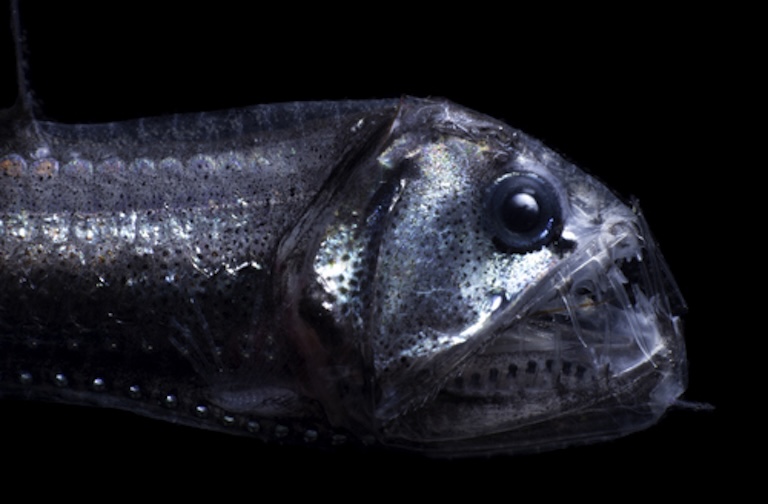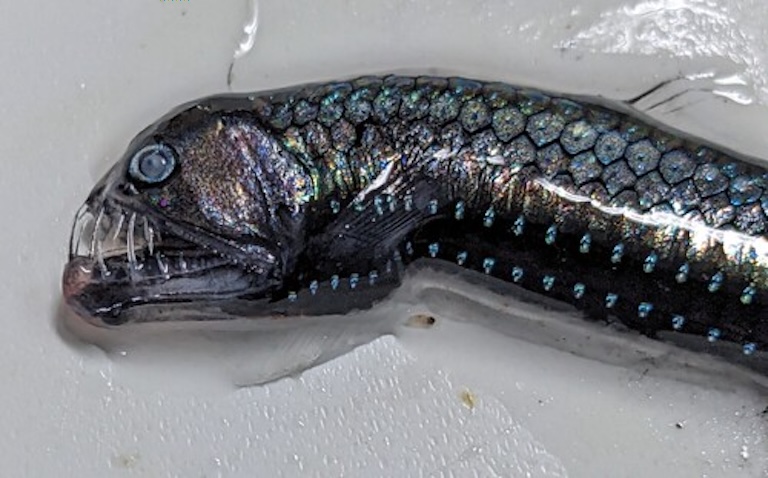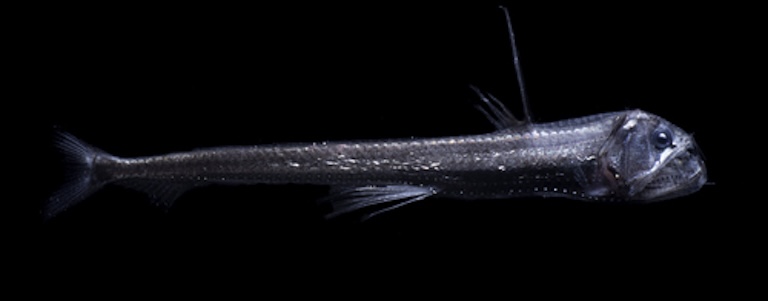Viperfish Profile
The deep sea worldwide is patrolled by quite a few animals that have artfully combined gormless expressions and enormous teeth to remind us that nature cares little for our comfort, and there really are killers down there that are beyond reasoning with.
The viperfish is one such animal. Thankfully, it’s not big enough to be of any threat to us, but it does sort of suggest there might be yet-undiscovered equivalents that could be.

Viperfish Facts Overview
| Habitat: | Marine, mid to deep waters (150 to 2,800 metres) |
| Location: | Tropical and temperate oceans worldwide |
| Lifespan: | Unknown |
| Size: | 35 cm (14 in) long |
| Weight: | 60+ grams |
| Colour: | Usually black and/or silvery, can be ghostly white |
| Diet: | Smaller fish, shrimp, and squid; even algae |
| Predators: | Larger predators, like tuna, cetaceans |
| Top Speed: | Slow |
| No. of Species: | 9 + |
| Conservation Status: | Least Concern |
The ability for this animal to hide in the darkness using light as camouflage makes it seem like some kind of fantasy creature from a tabletop board game, and the family it belongs to certainly contains some nicknames that support this hypothesis.
But this is very much a real fish, and a seriously creepy one, at that.
And perhaps even worse, it’s one of many such demons lurking in the deep oceans, waiting for nighttime to rise up and grab an unsuspecting swimmer.
Interesting Viperfish Facts
1. They’re dragonfish
Viperfish go by many names, but the family they belong to contains some of the most whimsical of all animal names, presumably conjured by a team of D&D players during the worldbuilding stage of a campaign.
Shiny loosejaws, snaggletooths and stareaters are among the incredible characters of this deep water family, and the group itself, Stomiidae, are known generally as the dragonfish. Though dragonfish are also a subcategory of this family, so it gets a bit confusing.
This is a family of fish that generally occupies darker waters, though they occur at a wide range of depths, and are known for their strong sexual dimorphism in which the females are many times the size of the males. They’re also known for being able to eat animals longer than themselves.
Viperfish are one genus in this family, and they tick all of those boxes and more. This genus contains some of the largest of the dragonfishes at over 30 cm in length, and they’re found across many species, almost anywhere there’s tropical and temperate marine water.

2. They have big mouths
There’s a lot to unpack at the front end of a viperfish. Its large eyes are pretty standard for an animal at this depth, but are unsettling every time, regardless. Its elongated body quickly thickens at the head to support a mouth that appears to make up more than a third of the animal’s mass, and in it are some spectacular glass needles that curve backwards and interlock like a cage.
These mouths can open beyond 90 degrees. They have to – those teeth don’t move, and so to part them, the jaw has to be incredibly mobile.
This big mouth is designed well for big food, and the viperfish is a stealthy killer in this regard.
3. And big teeth
This is a fish with teeth so big they can appropriately be called tusks. Not only are they too big to fit inside the mouth, but in some species, they extend past the head. These are piercing, gripping teeth, and once they get into a victim, there’s only one direction they will travel.
The viperfish’s teeth can be up to 10% of the length of the entire animal, and coupled with a powerful jaw and neck, the whole killing system is designed for clamping down with power and speed. 1
4. They migrate vertically
These are not fish you’d call energetic, as is the case with pretty much anything that lives at significant depth. Food is hard to come by, high metabolic strategies are too risky, and the viperfish doesn’t do a lot of active moving.
But it still migrates! Not so much around the ocean, but up and down within it, following the daily cycles as it emerges from the deep at night, so as not to be spotted, and then descends before the light emerges to hide safely in the dark. 2

5. They might take shifts
Not much is known about the ecology of the deep, and most of what we do know comes from animals that have been plucked from their murky homes by fishing boats.
The migration of the viperfish has been studied a bit, though, and it appears that they don’t need to feed all that often, or at least they don’t migrate up and down every day.
This might be a sign that they’re finding enough food in the depths and only migrate up when they’re struggling to feed, or it might be an adaptation to avoid competition. Splitting feeding migrations into shifts could reduce competitive pressure.
There’s also the element of temperature. These cold-adapted fish can’t handle heat above around 15 degrees Celsius, and so will only migrate into the upper levels when it’s sufficiently cool. 3
6. They glow in the light
Like many deep-sea fishes, these ones can produce their own light.
In this genus, there are two purposes for this: the first is the well-known lure, a blinking, attractive light that pulls curious animals to their doom.
The second is a very common, but lesser-known feature that camouflages the animal against the background.
You’d think producing light in the darkness would have the opposite effect, but even in the deep water, there is often light, albeit dim light. Animals adapted to this darkness will be able to see the shadow of a dark object against this ambient bioluminescence, and especially against the minimal amount of sunlight that gets to around 200 metres deep.
So, in order to camouflage themselves, many creatures mimic the ambient light levels and essentially project a cloak of indivisibility by matching their backgrounds and erasing their silhouette.
This process is called counter-illumination, and it’s an excellent deep-sea adaptation that makes predators such as the viperfish even more intimidating. 4
7. Tuna destroy them
For as scary as these viperfish are, they reach a humble length of just over 30 centimetres at most, and this definitely puts a limit on how far up the food chain they can get.
And while we’re on the topic of intimidating predators and under-appreciated adaptations, there are few animals on Earth less respected as predators than the tuna.
Some species of tuna are among the largest fish in the ocean, as well as some of the fastest, and they are active pursuit predators with immense power and grace. And they can make short work of a viperfish.
Viperfish are the main food source of many predators that we think of primarily in terms of canned food, such as the tuna, as well as some of the deeper-diving cetaceans, like the pygmy sperm whale.
Viperfish Fact-File Summary
Scientific Classification
| Kingdom: | Animalia |
| Phylum: | Chordata |
| Class: | Actinopterygii |
| Order: | Stomiiformes |
| Family: | Stomiidae |
| Genus: | Chauliodus |
| Species Name: | 9 known species |
Fact Sources & References
- Helen Scales (2022), “Discovered in the deep: the viperfish with fangs too big for its mouth”, The Guardian.
- , “Sloane’s Viperfish”, Ocean Twilight Zone.
- Eduardo et al. (2020), “Trophic ecology, habitat, and migratory behaviour of the viperfish Chauliodus sloani reveal a key mesopelagic player”, National Library of Medicine.
- Baguet (2002), “Bioluminescence of bathypelagic fish from the strait of messina”, Science Direct.
